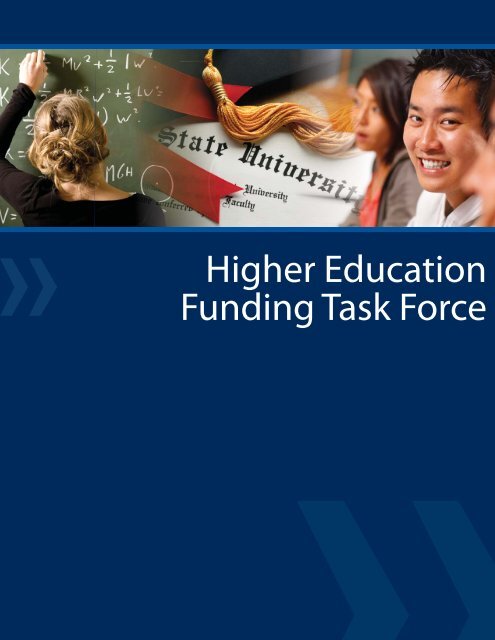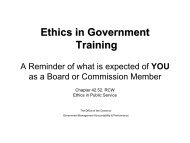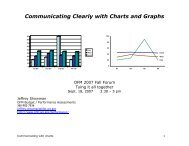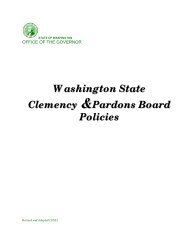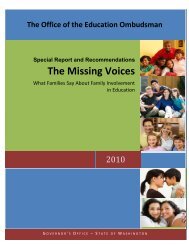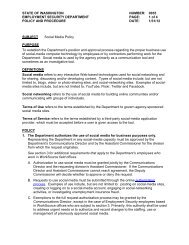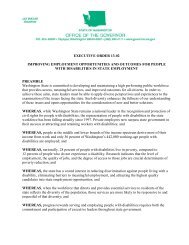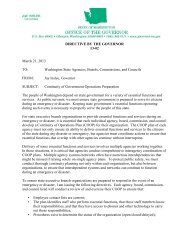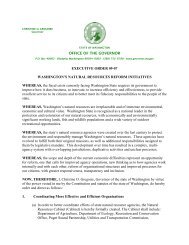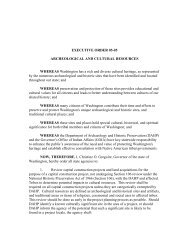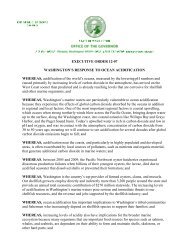Higher Education Funding Task Force
Higher Education Funding Task Force
Higher Education Funding Task Force
You also want an ePaper? Increase the reach of your titles
YUMPU automatically turns print PDFs into web optimized ePapers that Google loves.
<strong>Higher</strong> <strong>Education</strong><br />
<strong>Funding</strong> <strong>Task</strong> <strong>Force</strong>
Dear Governor Gregoire:<br />
<strong>Higher</strong> <strong>Education</strong><br />
<strong>Funding</strong> <strong>Task</strong> <strong>Force</strong><br />
January 3, 2011<br />
Over the past eight months, our group has worked to address a critical long-term issue for Washington<br />
State – ensuring that more of the kids who grow up here have the opportunity to earn a college degree.<br />
As we come together to release this report at the start of a New Year, we believe more passionately than<br />
ever that the State needs to renew its longstanding commitment to higher education. In the short term,<br />
this will play a vital role in creating new jobs and strengthening economic recovery. In the long term, this<br />
will fundamentally improve our children’s ability to attain a prosperous standard of living in an increasingly<br />
competitive world. These twin goals – jobs and opportunity – are even more important in a time of<br />
challenging economics.<br />
The <strong>Higher</strong> <strong>Education</strong> Coordinating Board’s Master Plan calls for a 27 percent increase in the number of<br />
students receiving bachelor’s degrees by 2018. Recent economic data suggest this focus is well placed.<br />
The current state unemployment rate for residents with a college degree is less than half the rate for those<br />
with only a high school diploma. And by 2020, we expect that two-thirds of the new jobs in Washington<br />
State will require postsecondary education.<br />
The situation is clear: if we want the next generation to be successful, we need to increase the number of<br />
students graduating from college.<br />
In order to realize this goal and maintain the longstanding commitment to quality education, the State needs<br />
to modernize the financial foundation for the six public four-year universities. This will require a variety of<br />
reforms and a willingness to embrace change. The only way to do this effectively will be to share in these<br />
changes together – as students, parents, businesses, universities, and other stakeholders.<br />
First, we recommend the State adopt a new financial formula for the public four-year universities<br />
that better combines state budget support with increased flexibility for the universities to set their<br />
own tuition rates.<br />
As discussed in the report, this would better enable our four-year universities to increase per-student<br />
funding to a level at or above the 60th percentile of each institution’s global challenge state peer group.<br />
Under this formula, if state budget support grows in the future, tuition increases will be smaller. We urge<br />
HIGHER EDUCATION FUNDING TASK FORCE
the legislature to sustain its financial support for higher education in the short term and grow it in the long<br />
term. But if state funding falls short, under this formula the universities will have the flexibility to fill in the<br />
gap through higher tuition.<br />
Second, we recommend the State take an innovative and sustainable step to establish a new<br />
source of revenue to provide financial aid for low- and middle-income students who want to<br />
attend college. Specifically, we recommend the creation of a new Washington Pledge Scholarship<br />
Program.<br />
As reflected by the existing budget challenges, the current approach to financing student financial aid<br />
leaves the State ill-prepared for economic downturns. Yet students’ ability to attend college should not<br />
depend on whether the State is enjoying good economic times when they turn 18. And given the current<br />
budgetary and tax climate, it’s not feasible simply to budget more money from existing revenue sources.<br />
Instead, we need to create a new revenue source and use this to establish a long-term, sustainable<br />
foundation for financial aid.<br />
Our goal is to create over the next decade a $1 billion endowment for Washington Pledge Scholarships,<br />
funded by new, voluntary individual and business donations and incentivized by federal and state tax<br />
provisions. By establishing this as a private nonprofit fund, the State can guarantee these funds will always<br />
be used for one purpose and one purpose only – ensuring that the gates of our community colleges and<br />
public universities remain open to students of all economic backgrounds.<br />
While individuals who contribute to the endowment will benefit from a federal income tax deduction, we<br />
recommend the State create an incentive for businesses to contribute as well, by providing within specified<br />
limits a 50 percent credit on Business and Occupation and public utilities taxes. While these tax credits<br />
would be earned upon making a contribution, they would be exercisable against these taxes only when the<br />
overall revenue generated from these taxes rises above FY2008 levels.<br />
Third, we recommend concrete steps to strengthen accountability and performance by the State’s<br />
public universities.<br />
Although we share a very high regard for the existing management at all six universities, we believe it’s<br />
important to take new steps that will strengthen these areas even further. These should start with the<br />
adoption of certain mandatory measurements from the National Governors Association’s Complete to<br />
Compete effort.<br />
The State should also institute a new incentive system that borrows from both the success of<br />
Washington’s recent program for community colleges and the success of the federal government’s recent<br />
Race-to-the-Top program. This will enable the legislature to invest limited additional funds to reward<br />
campuses that help more students complete their degrees.<br />
HIGHER EDUCATION FUNDING TASK FORCE
Finally, we believe the State should encourage new plans by the four-year universities to develop action<br />
plans to meet the State’s degree completion targets.<br />
We believe these recommendations will give our families and children the educational opportunities<br />
they need and deserve. They will create a stronger financial foundation for the universities, provide new<br />
scholarships for low- and middle-income students, and provide more public accountability for our tax dollars.<br />
If combined, they will enable more young adults in Washington State to go to college, and they will help our<br />
businesses create more jobs.<br />
Sincerely,<br />
Brad Smith, Chair<br />
Senior Vice President and<br />
General Counsel, Microsoft<br />
Corporation<br />
Dean Allen, CEO, McKinstry<br />
Company<br />
Bill Ayer, Chair and CEO,<br />
Alaska Air<br />
Maud Daudon, President<br />
& CEO, Seattle Northwest<br />
Securities<br />
Charlie Earl, Director, State<br />
Board for Community and<br />
Technical Colleges<br />
Jesus Hernandez, Chair,<br />
<strong>Higher</strong> <strong>Education</strong> Coordinating<br />
Board<br />
Michael Kluse, Senior Vice<br />
President, Battelle<br />
Alex McGregor, President<br />
& CEO, The McGregor<br />
Company<br />
Laura Peterson, Vice<br />
President, Boeing Company<br />
Thomas L. “Les” Purce,<br />
President, Evergreen State<br />
College<br />
Paula Reynolds, CEO,<br />
Preferwest LLC<br />
Chris Rivera, President,<br />
Washington Biotechnology<br />
and Biomedical Association<br />
Paul Rosier, Executive Director,<br />
Washington Association of<br />
School Administrators<br />
Judith Runstad, Foster Pepper<br />
LLC<br />
Ray Stephanson, Mayor of<br />
Everett<br />
David Tang, Managing Partner,<br />
Asia, K&L Gates LLP<br />
HIGHER EDUCATION FUNDING TASK FORCE
<strong>Funding</strong> Our Future:<br />
A Financial Blueprint for Strengthening<br />
<strong>Higher</strong> <strong>Education</strong> in Washington State<br />
Recommendations of the Governor’s <strong>Higher</strong> <strong>Education</strong> <strong>Funding</strong> <strong>Task</strong> <strong>Force</strong><br />
Executive Summary<br />
Washington’s future economic vitality will depend on expanding access to high-quality postsecondary<br />
education. By 2018, two-thirds of the jobs — and almost all good-paying jobs — will require workers with<br />
college degrees.<br />
The <strong>Higher</strong> <strong>Education</strong> <strong>Funding</strong> <strong>Task</strong> <strong>Force</strong> was appointed by the Governor to develop a plan for tackling<br />
this challenge.<br />
In the long term, Washington needs to renew and reshape its commitment to higher education and make<br />
sure the next generation is equipped to compete for the best jobs available. In the short term, the state<br />
must embrace a new way of delivering higher education, with a new incentive system that ties college<br />
graduates to state funds, a new source of revenue for college scholarships, and improved accountability<br />
at all six public universities.<br />
The <strong>Higher</strong> <strong>Education</strong> <strong>Funding</strong> <strong>Task</strong> <strong>Force</strong> recommends:<br />
• Increasing the number of Washington residents graduating with bachelor’s degrees from<br />
Washington’s colleges and universities, especially in high demand fields — science, technology,<br />
engineering, and math.<br />
• Providing the universities with increased flexibility to set tuition — linked to the level of state support<br />
and to the tuition charged by each institution’s peer colleges.<br />
• Expanding financial assistance to low- and middle- income students through a combination of private<br />
and public strategies, including a $1 billion endowment fund and tax incentives.<br />
• Holding each public university accountable for graduating more students with bachelor’s degrees,<br />
giving incoming students credit for high school coursework, community college studies and prior<br />
learning experiences, and revamping some academic programs.<br />
HIGHER EDUCATION FUNDING TASK FORCE
<strong>Higher</strong> <strong>Education</strong><br />
<strong>Funding</strong> <strong>Task</strong> <strong>Force</strong><br />
Challenges<br />
The issues confronting our state are:<br />
• Washington’s future economic vitality will depend on expanding access to high-quality postsecondary<br />
education. By 2018, two-thirds of the jobs will require workers with college degrees. According to a<br />
fall 2010 study by the Georgetown University Center on <strong>Education</strong> and the Workforce, Washington<br />
will rank 6th in jobs that require postsecondary education or special training.<br />
• Washingtonians who have only a high school degree have more difficulty finding work during the<br />
recession. In 2009, the average unemployment rate for individuals with a bachelor’s degree and<br />
higher was 4.6 percent, while the unemployment rate for those with only a high school diploma was<br />
10.5 percent.<br />
• The legislature’s commitment to making higher education a top priority in future state budgets is essential,<br />
as Washington’s economic vitality relies on a robust college system, even in difficult financial times.<br />
• Helping more students complete bachelor degrees will depend on the collaborative efforts of the<br />
education system to prepare our children for college, including preparation in K-12 and academic<br />
transfers from community colleges and technical schools.<br />
Washingtonians with a Bachelor’s Degree or More <strong>Education</strong><br />
are Less Likely to be Unemployed<br />
Chart 1<br />
<strong>Education</strong>al Level 2009 Washington Average Unemployment Rate<br />
Bachelor’s Degree or <strong>Higher</strong> 4.6%<br />
Some College or Assoc. Degree 7.7%<br />
High School Diploma 10.5%<br />
Less than High School Diploma 10.8%<br />
Nationally, Income Increases with <strong>Education</strong>al Attainment<br />
Chart 2<br />
Professional<br />
Doctorate<br />
Master’s<br />
Bachelor’s<br />
Associate’s<br />
Some College<br />
HS Graduate<br />
Some High School<br />
HIGHER EDUCATION FUNDING TASK FORCE<br />
Source: Bureau of Labor Statistics; Current Population Survey. 2009 Geographic Profile of the Employed and<br />
Unemployed. Compiled by the Washington State Employment Security Department.<br />
$70,186<br />
$57,181<br />
$39,746<br />
$33,009<br />
$31,286<br />
$21,484<br />
$95,565<br />
$120,978<br />
Source: U.S. Census Bureau, Current Population Survey. 2007.
Initial Charge<br />
The <strong>Task</strong> <strong>Force</strong> was asked to:<br />
• Develop a realistic and viable long-range funding strategy that provides Washington’s students<br />
with affordable higher education opportunities.<br />
• Recommend ways to improve accountability and performance in our public four-year higher<br />
education institutions to ensure we get the highest value for the State’s and student’s investment.<br />
And,<br />
• Consider whether the higher education system’s current governance model should be modified<br />
to improve overall performance and accountability. (Note: The <strong>Task</strong> <strong>Force</strong> decided not to address<br />
governance issues in order to focus its efforts on funding and other measures that will improve<br />
accountability.)<br />
Recommendation 1:<br />
Over the next decade, our higher education system must create the opportunities for more Washington<br />
residents to earn bachelor’s degrees.<br />
The following bachelor’s degree completion targets should be set for 2018:<br />
• Increase the number of bachelor’s degrees by 2018: Washington’s six public universities should<br />
graduate at least 6,000 more Washington resident students with bachelor’s degrees annually in 2018<br />
than they did in 2010. This recommendation, which is in sync with the <strong>Higher</strong> <strong>Education</strong> Coordinating<br />
Board’s goal in the 2008 Master Plan, represents a minimum threshold for the bachelor’s degree<br />
production our economy needs. In 2010, more than 22,000 students earned bachelor’s degrees at<br />
our public universities. By 2018, more than 28,000 students, or an increase of 27 percent, should be<br />
graduating with bachelor’s degrees.<br />
• Increase degrees in science, technology, engineering, and mathematics: Washington’s six public<br />
universities should see 2,000 more Washington<br />
resident students graduating annually with bachelor’s<br />
degrees in science, technology, engineering, and<br />
mathematics (STEM). This would represent roughly<br />
a 40 percent increase compared to current STEM<br />
degrees. Of the 22,000 bachelor degrees awarded at<br />
our public universities in 2010, just over 5,000 were<br />
earned in these academic areas.<br />
Washington Ranks 36th in the<br />
Nation in the Production of<br />
Bachelor’s Degrees<br />
All institutions, public and private,<br />
among 18-24 year olds.<br />
Source: U.S. Department of Commerce. 2006.<br />
Compiled by the Puget Sound Regional Council.<br />
• Expand opportunity for underrepresented groups:<br />
By 2018, at least 19 percent of the bachelor degrees<br />
awarded should go to graduates from historically<br />
underrepresented groups. This percentage is based on changing demographics and our belief that<br />
college campuses must include more low-income and first-time college students.<br />
HIGHER EDUCATION FUNDING TASK FORCE
Recommendation 2:<br />
Provide sufficient investment by linking tuition and state support. This is fundamental to providing<br />
an affordable, accessible, higher quality education for Washington’s citizens and to meeting the degree<br />
and access goals for 2018. As we climb out of the recession and build for the future beginning in 2013,<br />
it’s clear that educational access and attainment can be delivered only with a realistic financing framework<br />
in place. Our universities need certainty to plan for the future. State investment and tuition must be<br />
integrated to provide predictable and stable funding as follows:<br />
• Benchmarking total per student funding: Total per-student funding is benchmarked against two<br />
figures: a baseline of the fiscal year 2011 per-student funding and an aspirational level at or above the<br />
60th percentile of each university’s global challenge state peer group.<br />
o If state funding rises to the aspirational funding level or above, tuition may be frozen or even<br />
reduced if the State provides more support. The universities would increase enrollment to meet<br />
or exceed the degree production goals.<br />
o If state funding remains at the baseline level or above, the universities will commit to<br />
continue serving fiscal year 2011 enrollment levels and tuition increases will be capped at the<br />
60th percentile of that university’s state peer group.<br />
o If state funding falls below the baseline level, in order to maintain the baseline level, the<br />
universities would have the option to reduce enrollments or increase tuition without a cap or do<br />
both.<br />
• Give universities the authority to set tuition rates: The governing boards of each university should<br />
be allowed to set tuition. The following limits would be placed on that authority:<br />
o If state funding is at or above the baseline, tuition cannot exceed the 60th percentile of that<br />
university’s state peer group. A percentage of tuition increases shall be dedicated to financial aid.<br />
o If state funding falls below the baseline, in order to maintain the baseline level, the institutions<br />
would have the option to reduce enrollments or could increase tuition without a cap, or do both.<br />
o Tuition may go down if the aspirational funding level is exceeded.<br />
HIGHER EDUCATION FUNDING TASK FORCE
Recommendation 3:<br />
Help low- and middle-income Washington students earn a bachelor’s degree by creating the<br />
Washington Pledge Scholarship Program.<br />
• Establish the Washington Pledge Scholarship: A new endowment program should be created<br />
with a goal of raising $1 billion by the end of this decade as a legacy that will help future generations<br />
of Washington students attend college. This scholarship will provide much needed help for low- to<br />
middle-income Washington students at our public two- and four-year colleges and universities.<br />
• This endowment would be created with new money and would come from new sources of<br />
revenue. Private donations from both individuals and business will fund the endowment. In working<br />
through the details to create this fund, consideration should be given to enabling donations to target<br />
specific programs or students, potentially with a special priority for students who want to pursue<br />
STEM degrees.<br />
o Individual Donations: The endowment should accept individual donations and should be set up<br />
as a nonprofit to qualify for federal tax deductions. This structure would help incentivize individual<br />
donations and ensure that the endowment will always be used for these scholarships and for no<br />
other purpose. The <strong>Higher</strong> <strong>Education</strong> Coordinating Board could administer the program.<br />
o Business Donations: The endowment should also accept contributions from the business<br />
community. The State should establish a credit equal to 50 percent of the amount donated to<br />
be applied against the Business and Occupation tax and public utilities tax that could be earned<br />
under the new program. This would both create a financial incentive for businesses to make<br />
these new voluntary donations and, in effect, enlist State resources to help build a sustainable,<br />
long-term financial foundation for the education of future generations.<br />
• Given current State budget challenges, we need to take a pragmatic approach to the timing<br />
and recognition of this tax credit. We recommend that the credit could be earned upon<br />
making the contribution but could not be claimed until state sales, use and Business &<br />
Occupation tax collections exceed FY 2008 collections by 10 percent and would not be<br />
available earlier than January 1, 2014. The credit would be a percentage of the amount<br />
donated. A cap would be placed on the amount of credit that could be claimed in a year both<br />
under the program and by a single business.<br />
HIGHER EDUCATION FUNDING TASK FORCE
Recommendation 4:<br />
Strengthen accountability and performance in higher education.<br />
Through specific accountability measures, improved performance and recognizing credits earned,<br />
students will be better served.<br />
• Adopt the National Governors Association’s Complete to Compete measures: Washington<br />
should adopt the association’s Complete to Compete indicators as statewide accountability<br />
measures. This will provide universities and the state a way to collect comparable data to make<br />
better policy decisions, pinpoint areas for improvement, and measure success.<br />
o The measures include:<br />
HIGHER EDUCATION FUNDING TASK FORCE<br />
• Outcome metrics: Degrees awarded, graduation rates, transfer rates, and time and credits to<br />
degree.<br />
• Progress metrics: Enrollment in remedial education, success in remedial education, success<br />
in first-year college courses, credit accumulation, retention rates, and course completion.<br />
• Develop an incentive system for improved accountability and performance: The legislature should<br />
also create limited financial incentives to reward progress by the six public universities in meeting<br />
bachelor degree completion targets. In designing the system, the State should clearly articulate each<br />
individual university’s role and action plan. Each university should be required to participate in the<br />
incentive system. The <strong>Higher</strong> <strong>Education</strong> Coordinating Board should design and oversee the incentive<br />
program. Incentive awards should be provided for progress based on the following:<br />
o Increases in the number of degrees awarded in the physical and health sciences, technology,<br />
engineering, and mathematics.<br />
o Increases in the retention of first-year students receiving need-based assistance.<br />
o Time and credit to degree, including a reduction in the number of credits accrued beyond what is<br />
required to earn a bachelor’s degree.<br />
o Total number of bachelor’s degrees awarded.<br />
• Have universities develop action plans to meet goals and reduce costs. The State should<br />
encourage the universities to develop action plans that specify degree completion targets, the<br />
action steps taken to reach the targets, and the results. Results should be reported annually to the<br />
legislature. The potential menu of options could include but not be limited to:<br />
o Innovative use of technology in instruction, particularly for large introductory courses.<br />
o Increasing administrative efficiencies among the universities and campuses.<br />
o Eliminating under-used majors and courses.<br />
o Creating three-year bachelor degree programs.<br />
o Limiting state support for students taking credits beyond those needed to earn a degree.
o Recognizing prior learning experiences based on competency assessments.<br />
o Recognizing advanced high school work, such as advanced placement or international<br />
baccalaureate courses with proficiency exams and college credits earned in high school through<br />
programs such as Running Start.<br />
o Recognizing transfer credits – particularly credits earned in academic programs at two-year or<br />
four-year institutions.<br />
• Recognize credit from high school and other colleges: Students should receive credit at the six<br />
public universities for college-level work completed at a high school, a community college or another<br />
four-year university.<br />
o College credit earned in high school: The universities should be required to have uniform<br />
policies for awarding credit to high school students who successfully complete college-level<br />
work through Running Start or college in the high school programs. The universities should also<br />
have uniform policies for awarding credit to high school students who successfully complete<br />
both the coursework and exams in advanced placement or international baccalaureate programs.<br />
The universities should make information widely available to students about the ability to earn a<br />
college degree in three years after high school when a high school student completes academic<br />
work qualifying for college credit.<br />
o Transfer of credits: The universities should be required to provide for a seamless transfer<br />
process and maximize academic credits earned at other institutions of higher education.<br />
o Prior learning experiences: The universities should be required to strengthen policies for<br />
awarding credit for prior learning experiences with demonstrated competencies through<br />
proficiency exams. Information about proficiency exams to earn college credit should be<br />
consistent and widely available.<br />
HIGHER EDUCATION FUNDING TASK FORCE
<strong>Higher</strong> <strong>Education</strong><br />
<strong>Funding</strong> <strong>Task</strong> <strong>Force</strong><br />
Members:<br />
Brad Smith, Chair, Senior Vice President and General Counsel, Microsoft Corporation<br />
Dean Allen, CEO, McKinstry Company<br />
Bill Ayer, Chair and CEO, Alaska Air<br />
Maud Daudon, President & CEO, Seattle Northwest Securities<br />
Charlie Earl, Director, State Board for Community and Technical Colleges<br />
Jesus Hernandez, Chair, <strong>Higher</strong> <strong>Education</strong> Coordinating Board<br />
Michael Kluse, Senior Vice President, Battelle<br />
Alex McGregor, President & CEO, The McGregor Company<br />
Laura Peterson, Vice President, Boeing Company<br />
Thomas L. “Les” Purce, President, Evergreen State College<br />
Paula Reynolds, CEO, Preferwest LLC<br />
Chris Rivera, President, Washington Biotechnology and Biomedical Association<br />
Paul Rosier, Executive Director, Washington Association of School Administrators<br />
Judith Runstad, Foster Pepper LLC<br />
Ray Stephanson, Mayor of Everett<br />
David Tang, Managing Partner, Asia, K&L Gates LLP<br />
1 | HIGHER EDUCATION FUNDING TASK FORCE


